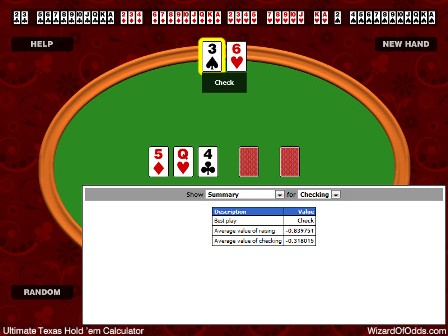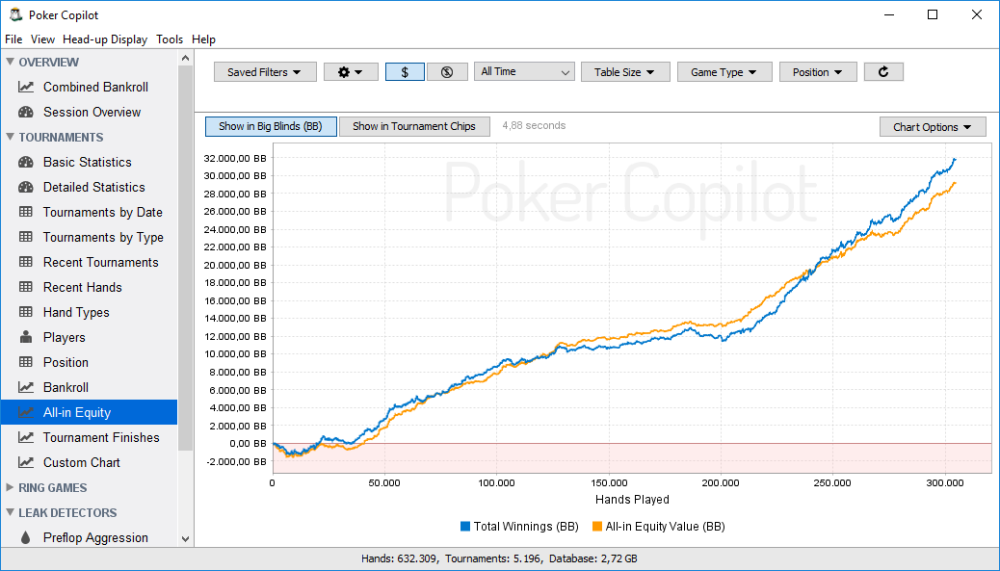Texas Holdem Expected Value Chart
- See All Results For This Question
- Texas Holdem Percentage Chart
- Texas Holdem Expected Value Chart
- Poker Cheat Sheet [2020] Learn Texas Holdem In 5 Minutes
- Texas Holdem Expected Value Charts
Poker odds charts come in useful when you want to quickly work out the odds of winning a hand in Texas Hold'em. The most commonly used odds charts are the 'standard poker odds charts' below, which give both the percentage and ratio odds of completing your draw depending on the number of outs you have (see pot odds and drawing hands for more information).


Learn to play Online Texas Holdem like a Pro! Expected Value for 9 Players. Cards: Position: SB: BB: 3: 4: 5: 6: 7: 8: D: AA: 2.65: 2.67: 2.35: 2.55: 2.48: 2.54. Expected value is the amount of money you would win or lose, on average, on your bet The Math of Expected Value If you and a friend were to bet on the outcome of a coin flip, and agree that you would be paid $5 for every time it came heads and you would pay him $5 every time it came tails, you would win half the time and he would win the other. In Texas Holdem the expected value of your first two cards depend on the cards you have, your position on the table, and the number of players at the table. In other words you will be happy to know that in the dealer position (on the button) pocket aces yield an EV of 2.96 when there are ten players at the table. Texas Holdem Tournament.Com: Expected Value for 6 Players. Cards: Position: SB: BB: 3: 4: 5: D: AA: 2.62: 2.26: 2.05: 2.58: 2.53: 2.38. Learn to play Online Texas Holdem like a Pro! Expected Value for 9 Players. Cards: Position: SB: BB: 3: 4: 5: 6: 7: 8: D: AA: 2.65: 2.67: 2.35: 2.55: 2.48: 2.54.
See All Results For This Question
The second set of odds charts highlight interesting odds for different situations in Texas Hold'em. These will help you get to grips with the different likelihood's and chances within the game of poker.
Standard poker odds charts.
Other poker odds charts.
Texas Holdem Percentage Chart
Why use these odds charts?
There are currently many odds charts on the Internet at numerous poker websites. However many of these can be tricky to use. ThePokerBank provides easy to use charts highlighting the key draws on each, which makes them simple and effective to use during play.
I am confident that these odds charts are the easiest charts that you will ever use.
How to use poker odds charts.
Texas Holdem Expected Value Chart
Poker odds charts help you to determine how much you can call when trying to complete a drawing hand, such as a flush or a straight draw. By comparing your pot odds with the odds of completing your draw, you can work out whether or not it will be profitable to call certain sized bets from your opponents.
Poker odds charts are most commonly used when working out pot odds.
It is perfectly possible to work out the odds of completing a draw in your head, but these odds charts make things much easier if you are looking for a quick reference or if you're just starting out. However, over time it is a good idea to learn the most common odds so that you no longer have to refer to any charts whilst you play.
Work out probabilities for yourself.
Don't just take my word for it or settle for the probabilities I've listed on the site, try working out probabilities for yourself. It's not as tricky or mathsy as you might think.
My guide on how to work out preflop hand probabilities gives a nice overview on basic starting hand probabilities. For flop probabilities and the likelihood of different combinations of cards on the flop, try the article on working out flop probabilities.
Go back to the handy Texas Hold'em tools.
There are 1 326 different starting hands in Texas hold'em, but if you leave out the different color constellations there are totally 169.
Which starting hands a player should play is something that has been discussed in many books about poker. By dividing different hands into categories could be helpful for the ranking. This gives an oversight and that method are going to be used here also.
The categories below are only based on the objective strength of the starting hands; therefore, it's not sure that a specific play should be applied on all starting hands in the same category. A-A (two aces) are clearly the best starting hand and there are never an option to fold with it, which may be the case for other hands in 'Category 1'. In the choice of starting hands, you must also consider how many players there are on the table, which structure you are playing in and your own playing style (other articles on this site focus on these subjects).
Abbreviations used: A (Ace), K(King), Q (Queen), J, (Jack), T (Ten), s (suited)
Category 1

A-A
K-K
Q-Q
J-J
A-Ks
General playing instructions: Play in almost all situations and normally raise, re-raise or 4-bet.
Category 2

A-Qs
K-Qs
A-Js
T-T
A-K
A-Ts
General playing instructions: Play in almost all situations and normally raise or re-raise.
Category 3
A-Q
9-9
K-Js
8-8
A-J
K-Ts
Q-Js
K-Q
General playing instructions: Play in most situations and normally raise and sometimes re-raise.
Poker Cheat Sheet [2020] Learn Texas Holdem In 5 Minutes

Category 4
Texas Holdem Expected Value Charts
A9s
QTs
77
JTs
A8s
A-T
K9s
A7s
KJ
6-6
T-9s
General playing instructions: Play in late positions and sometimes in midle positions depending on the circumstances.
The list will not necessarily correspond to which starting hands that win most in practical play – a good term for this is ”equity-realization”, which is more about the effective odds than general playability. Which hand that works in practical play depends on different factors. One is that it's very easy to overplay some cards, like A-K. Another kind of 'problem hands' is J-J and T-T. These are big hands, but the value of them decreases when a queen, a king or an ace hits the table.
Number of combinations for different hand categories
The most common hands are offsuited hands. Each offsuited hand have twelve possible combinations.
For example A-Ko: A♥-K♦, A♥-K♣ ,A♥-K♠, A♦-K♥, A♦-K♣, A♦-K♠, A♣-K♦, A♣-K♣, A♣-K♠, A♠-K♦, A♠-K, A♠-K♣.
The next most common hands are the pairs. Each pocket pair have six possible combinations.
For example A-A: A♥-A♦, A♥-A♣, A♥-A♠, A♦-A♣, A♦-A♠, A♣-A♠.
The least common hands are the suited hands. Each suited hand have four possible combinations.
For example A-Ks: A♥-K♥, A♦-K♦ ,A♣-K♣, A♠-K♠.
Starting hands charts
All starting hands in Texas hold'em can be displayed shematically in a chart:
All hands, both with suited and offsuited versions are included. The real benefit of these charts appear when they display ranges, as we will se below.
The green color marks which cards to play. It tells, for example, that if your hole cards are QT (queen-ten) you should probably play, but if your hole cards are Q5 (queen-five) you should fold. In the chart, only about 10% av the hands get a green light, which is a rather tight pre flop disposition. There are many ideas and theories about how many hands should you play in poker; see starting hands ranges for more examples and information about this.
Related articles: